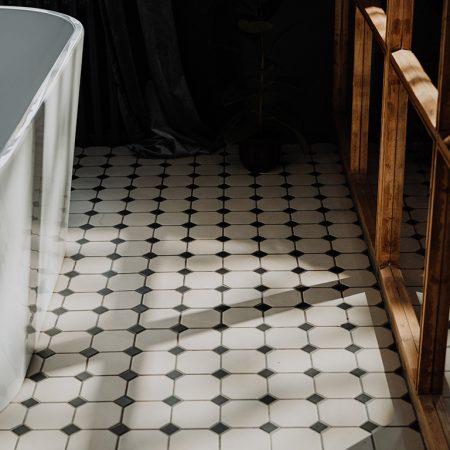- Mechanical characteristics: referring to the ceramic tile’s capacity to support weight (tensile breaking load) and wear resistance (abrasion resistance) during use.
- Slip resistance: The measurement of this property followed the method detailed in the Technical Building Code, which classifies floorings into four categories: no requirements; dry interior floors; interior floors with slopes or wet floors; and wet interior floors with slopes, floors with grease, lubricants, etc., and exterior floors and swimming pools.
- Additional characteristics: relating to “outdoor use” or to installation in premises subject to aggressive cleaning “hygienic use”.
The installation and placement of a ceramic tile is a process in which the appropriate tile installation technique must be selected based on all the factors involved.
The ceramic tile installation technique will be selected according to the projection of the system and the functional requirements of the covering. Initially, the substrates, environmental conditions and requirements of use will be diagnosed in order to be able to select the ceramic tile appropriately, and depending on this process, the bonding and grouting materials will be selected. The following are some general recommendations to be taken into account for the installation of ceramic tiles, although it is essential to have qualified professionals for their execution in each case.
Layout of the space: verification of the measurements of the space to be tiled, levels, plumb of walls, fullness, etc. A joint distribution should be sought that avoids narrow strips and tile cuts.
Fixing substrates: carry out a diagnosis of the surface, taking into account: the stability of the base; the compressibility of the intermediate layers; the flatness, cohesion, water absorption, texture, chemical compatibility and condition of the fixing surface that will receive the bonding material.

How
Most ceramic tiles are installed by the thin-bed technique using cementitious adhesives, dispersion adhesives or reaction resin adhesives. The thick-bed technique with cement mortar is restricted to tiles with a water absorption capacity of more than 3% and with a format of less than 900cm2 on stable substrates without intermediate layers.
For a correct placement we will follow the following indications.
Grouting: it is carried out at least 24 hours after the ceramic pieces have been laid.
Cleaning: to remove the remains of cement, joint sealing materials and any other residue, slightly acid descaling detergents should be used. It is advisable to impregnate the surface with clean water prior to any chemical treatment to avoid possible absorption of the agents used by the grouting materials.
General tips
- Select the type of adhesive according to the destination, substrate, format and water absorption capacity of the tile.
- It is important to make sure that the tile installation is carried out within the open time of the adhesive to avoid the formation of a dry film that may impair adhesion.
- The width of the joint depends on the tile format and the foreseeable use and stress to which the installation will be subjected.
- It is not advisable to use a tile joint of less than 3 mm. In no case can it be installed without a joint.
nance
Due to the nature of their surface, ceramic materials avoid adhesion phenomena, and if this is produced by an intermediate vehicle (grease, etc…), it is easily removed by washing with a diluted solution of commercial detergent.
Here are some tips for carrying out the following maintenance activities:
Initial cleaning after finishing the work
- Acid cleaning should never be carried out on freshly laid tile, because the acid reacts with the uncured cement and may deteriorate the joints or deposit insoluble compounds on the surface of the tile.
- It is advisable to impregnate the surface with clean water prior to any chemical treatment, to prevent the possible absorption of the agents used by the grout and by the ceramic substrate, and to rinse with water immediately after the treatment, to eliminate the remains of chemical products.
- This type of operation should be carried out by experienced personnel, taking into account the characteristics of the tile and the manufacturer’s recommendations.




